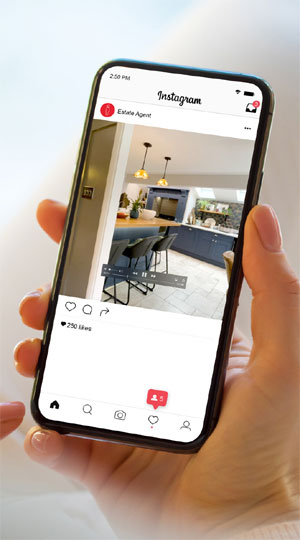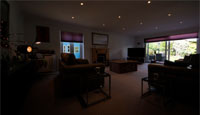
Whether we choose to believe it or not, how people find brands (including property), consume messages, build trust and make purchases is heavily influenced by the internet – chiefly social media. It’s a generational shift and agents need to shift with it.
In researching this article, one thing was astoundingly clear. Agents need to be in tune with Millennials (that’s those born between 1981 and 1996, to save you Googling) and all the generations below. The oldest Millennial will be 42 this year – an age by which many have bought their first and even second home. Then there’s Gen Z, which encompasses people in their early 20s – those in rentals and saving for a deposit. These are your current and future clients, who can’t be ignored.
Being in tune means understanding where Millennials and Gen Z browse – specifically for properties. Those already feeling uncomfortable with the new demographic lexicon do need to stay in touch an.
New research by property communications agency Oracle, in partnership with YouGov, found just 28% of 18-24 year olds (Gen Z) cited property portals as the information source they most trusted when looking for a home to buy or rent. When it came to Millennials, the figure was an average of 44% – not even half.
Oracle said the statistics reflected a wider trend among Gen Z – a group of consumers who tended to ‘be wary of traditional advertising and product campaigns, instead preferring influencers, social proof and personal recommendations’. When the agency spoke to one 20-year old, she said social media and influencers are ‘more favourable’ than Zoopla, for example, and that she has learnt about shared ownership and Help to Buy from Instagram and TikTok.
Is time ticking for property portals?
 The Oracle Group’s Caroline Coskry says its research indicates that disruption is on its way. “Websites, such as Rightmove and Zoopla, have been central to British house-hunting habits for around two decades now but that dominance could soon be disrupted. Gen Z places far less faith in portals than the generations that came before, opening the door for new forms of property marketing to win their trust.”
The Oracle Group’s Caroline Coskry says its research indicates that disruption is on its way. “Websites, such as Rightmove and Zoopla, have been central to British house-hunting habits for around two decades now but that dominance could soon be disrupted. Gen Z places far less faith in portals than the generations that came before, opening the door for new forms of property marketing to win their trust.”
Gen Z places far less faith in portals than the generations that came before, opening the door for new forms of property marketing to win their trust. Caroline Coskry CEO, The Oracle Group.
So where does this research leave property listings? The portals won’t disappear overnight but there is the suggestion their power will ebb as the years pass and Gen Alpha (those aged from 0 to 9 years) mature and become movers. It’s a notion that was discussed on a recent ‘Pass The Syrup’ property podcast. One guest christened social media as the modern-day branch window, where the online content attracted passive movers in the same way as a printed listing would stop a pedestrian in their tracks.
Taking the tour
 Someone who is already dialled into the habits of younger generations is Andrew Nicholls at EyeSpy360 – a creator of virtual tours, 3D models, floorplans and teaser videos that are advertised as perfect for Facebook, Instagram and YouTube. “We know that more than 80% of Millennials would like to view virtual tours and digital floor plans when shopping for a home,” says Andrew.
Someone who is already dialled into the habits of younger generations is Andrew Nicholls at EyeSpy360 – a creator of virtual tours, 3D models, floorplans and teaser videos that are advertised as perfect for Facebook, Instagram and YouTube. “We know that more than 80% of Millennials would like to view virtual tours and digital floor plans when shopping for a home,” says Andrew.
80% of Millennials would like to view virtual tours and digital floor plans. In fact, 54% of these buyers will not even look at a property unless it offers virtual images. Andrew Nicholls, EyeSpy360.
“We know that listings with a virtual tour get 87% more views than those without one, and that customers in the 18 to 34 year-old age group are 130% more likely to book a viewing based on a virtual tour. In fact, 54% of these buyers will not even look at a property unless it offers virtual images.”
Despite this knowledge, Andrew highlights how the UK has fallen behind when it comes to listing assets, finding only 5% of UK agents consistently offer virtual tours. That figure, however, can be an advantage, with home movers prioritising listings with a virtual tour over others.
Screen time is up
 Video is another asset that agents should be embracing when it comes to listings, as the return on investment when filming is generally excellent. As well as being able to extrapolate high quality stills from footage – ideal for those who produce printed brochures and also perfect for portal listings – video is the content both social media and Google loves. Simply uploading a video to Instagram, Facebook or TikTok and pasting the wording used on Rightmove won’t cut it, however.
Video is another asset that agents should be embracing when it comes to listings, as the return on investment when filming is generally excellent. As well as being able to extrapolate high quality stills from footage – ideal for those who produce printed brochures and also perfect for portal listings – video is the content both social media and Google loves. Simply uploading a video to Instagram, Facebook or TikTok and pasting the wording used on Rightmove won’t cut it, however.
There are trailblazers who agents should look to for the right way to use videos in listings, especially in the Build to Rent sector. Here agents have flipped from traditional marketing to content creation. Head to Moda Living’s Instagram feed and choose the reels tab for enlightenment (@livethemodalife). Its breezy property tours are set to trending music, feature captions in that oh-so-familiar Instagram font and have snappy, hashtag-laden listing copy, such as ‘we’re just gonna leave this one here.’
Video is currently a major trend that increases visibility and engagement over both still images and the written word. Peter Burnham Managing Director, Nichecom.
 Just as important is the Instagram account structure: brand description, linktree and the tagging of tenants: aspirational yet relatable and full social proof. It’s the cutting-edge reincarnation of a printed property listing. Yes, this style may feel very uncomfortable to the traditional agent – but a video of a one-bedroom flat near Leeds coach station has thousands of views.
Just as important is the Instagram account structure: brand description, linktree and the tagging of tenants: aspirational yet relatable and full social proof. It’s the cutting-edge reincarnation of a printed property listing. Yes, this style may feel very uncomfortable to the traditional agent – but a video of a one-bedroom flat near Leeds coach station has thousands of views.
 When asked what combination of assets an agent should use when preparing listings for social media, Peter Burnham at Nichecom says it can be hard to know what might get engagement and results during any given week. “It can be difficult to pin down a set formula as each social media platform has a unique algorithm that rewards the right combination of digital media assets. These algorithms are constantly evolving but video is currently a major trend that increases visibility and engagement over both still images and the written word,” says Peter.
When asked what combination of assets an agent should use when preparing listings for social media, Peter Burnham at Nichecom says it can be hard to know what might get engagement and results during any given week. “It can be difficult to pin down a set formula as each social media platform has a unique algorithm that rewards the right combination of digital media assets. These algorithms are constantly evolving but video is currently a major trend that increases visibility and engagement over both still images and the written word,” says Peter.
Not just aimlessly scrolling
It’s important to stress that many agents are starting to realise the synergy between video-based listings and social media consumption. “Agents are requesting shorter, more creative video bites in portrait format over landscape,” adds Peter (portrait videos are what Instagram and TikTok prefer but agents will need to pay attention to platform-specific aspect ratios).
“With home movers getting younger and often listening to content with sound off, headers, labels and text overlays are becoming essential for conveying vital information. A brief agent intro and outro is a popular formula, especially now there is less demand for lengthy walkthroughs with detailed explanation of each room.”
 Not convinced when it comes to creating a TikTok property listing? Tom Durrant at DCTR draws attention to the platform’s location and behaviour targeted adverts. This function allows agents to hone in on users in desired postcodes or perhaps those who have already watched property videos. A combination of an engaging video and pin-point geographical targeting is definitely something to explore, especially given Oracle’s findings.
Not convinced when it comes to creating a TikTok property listing? Tom Durrant at DCTR draws attention to the platform’s location and behaviour targeted adverts. This function allows agents to hone in on users in desired postcodes or perhaps those who have already watched property videos. A combination of an engaging video and pin-point geographical targeting is definitely something to explore, especially given Oracle’s findings.
The right orientation and ratio for each social media platform is now paramount, and we’re leaning towards short lifestyle clips – they type that stop people scrolling on past. Tom Durrant Director, DCTR.

DCTR’s use of HDR produces one balanced photo from multiple bracketed shots.



Set the wheels in motion
There is a happy medium for agents who want animated listings in order to enter into the TikTok and Instagram fray but don’t have the time, money or nature of stock to capture an entire property in its full blown technicolour glory. As Peter alludes to, bite-sized clips, animated elements and even still images stitched together with music and captions all qualify as a video.
High Dynamic Range photography relates to image bracketing – when multiple photos of one room or scene are taken at different exposures, allowing views out of a window to be visible.
“We’re seeing a new focus on snappier, shorter animations, especially for the new homes sector,” comments Tom. “The right orientation and ratio for each social media platform is now paramount, and we’re leaning towards short lifestyle clips – they type that stop people scrolling on past.” DCTR is commonly asked to animate CGIs to promote new developments and can also produce films that splice interviews, local area footage and still images together, and create CG animations that blend a virtual world with the real one.
Virtual reality versus virtual insanity
And there we have. A mention of virtual reality (VR) and it would be remiss to leave out this and AI (Artificial Intelligence) when discussing listing. Did you know there’s AI interior tuning that adjusts how a room looks in the same way face tuning modifies noses and jawlines?
The digital manipulation of listing assets isn’t a new issue in property and as a result, misleading images, video clips and floorplans constitute a breach of Consumer Protection from Unfair Trading Regulations 2008.
 Ryan Al-Sharieh at Giraffe360 says agents tempted to take advantage of more sophisticated image editing and even AI-powered deep fakes should be wary. “Property listings are already synonymous with being misleading, such as the inclusion of fish-eye photographs. If deep fakes do hit the agency sector, they will just be an evolution of what we’ve all seen before.”
Ryan Al-Sharieh at Giraffe360 says agents tempted to take advantage of more sophisticated image editing and even AI-powered deep fakes should be wary. “Property listings are already synonymous with being misleading, such as the inclusion of fish-eye photographs. If deep fakes do hit the agency sector, they will just be an evolution of what we’ve all seen before.”
Property listings are already synonymous with being misleading. Agents who establish truth and trust early in the listing will be the ones who succeed. Ryan Al-Sharieh VP Product, Giraff360.
A click away from misrepresentation
 “AI is a tricky one,” says PlanUp’s Steven Flatman. “The new Photoshop (Beta,) with its AI-powered generated fills, allows anyone to replace the sky behind a property, for example, but you have to be careful. It can also remove or alter elements that could lead to a property being visually misrepresented, such as deleting a tree or electricity pylon.”
“AI is a tricky one,” says PlanUp’s Steven Flatman. “The new Photoshop (Beta,) with its AI-powered generated fills, allows anyone to replace the sky behind a property, for example, but you have to be careful. It can also remove or alter elements that could lead to a property being visually misrepresented, such as deleting a tree or electricity pylon.”
The floorplan is still king. This gives home movers the best gauge of how big a property is and what the layout is in its truest form. Steven Flatman, PlanUp.

PlanUp’s floorplans give an instant impression of a property’s interior.
 It’s a fear shared by Mitch Handley at Inventory Hive. “There’s still a long way to go in terms of AI and property listings – everyone involved has to be aware of representation. Videos can be too polished, too edited and too tweaked,” says Mitch. “It’s the whole ‘Insta versus reality’ situation. In contrast, using virtual tours across social media helps grab attention and give a true representation of a property.”
It’s a fear shared by Mitch Handley at Inventory Hive. “There’s still a long way to go in terms of AI and property listings – everyone involved has to be aware of representation. Videos can be too polished, too edited and too tweaked,” says Mitch. “It’s the whole ‘Insta versus reality’ situation. In contrast, using virtual tours across social media helps grab attention and give a true representation of a property.”
There’s still a long way to go in terms of AI and property listings – everyone has to be aware of representation. Videos can be too polished and too tweaked. Mitch Handley, Inventory Hive.
Ryan says that as with celebrities who peddle fake levels of beauty and thinness, home movers will eventually see a property in person and the myth that is a manipulated image will be shattered. “Agents who establish truth and trust early in the listing will be the ones who succeed, especially in a more challenging market.”
The AI attributes we should welcome
That’s not to say AI doesn’t have its place in property. Giraffe360 prefers to fine tune its AI models to increase the speed of content production, with the aim of getting virtual tours and videos back to its clients even faster.
At DCTR a new launch will see HDR photo enhancing included in every image edit as standard, at no extra cost to agents. HDR – High Dynamic Range photography – digitally enhances a photograph using AI algorithms. Its property application relates to image bracketing – when multiple photos of one room or scene are taken at different exposures. Without bracketing, windows can appear white and blown out but with a simple DSLR camera setting, a set of photos is taken. When these are uploaded to DCTR, the team will use HDR to produce a balanced image where views out of a window are visible.
Floor fillers
Are we saying the most traditional of listing assets are dead in the water? Definitely not. “The floorplan is still king,” says Steven. He says they are a gateway to clicking on the other assets featured in a listing. “You can’t beat looking at a floorplan. This gives home movers the best gauge of how big a property is and what the layout is in its truest form.”
Steve describes an asset hierarchy when it comes to property listings – photographs, floorplan and then a video or a virtual tour. “On a search results page, good photos help people narrow down what properties they will click through to, then browsers will study the floorplan. If people don’t like what they see on a floorplan, they won’t click on a virtual tour or watch a video.”
Even with AI snapping at its heels, PlanUp is close to launching its biggest update in 10 years, with an Android compatible version of its software, a floorplan vault that will include 1,000s of agent-accessible plans and an improved synergy with domestic energy assessors.
The not-so secret code
QR codes had a false start in property., but the pandemic changed all that. Mitch says QR codes now provide an important bridge between printed and digital property listings.
“QR codes are now essential, especially if agents want to promote virtual tours in their print marketing, comments Mitch. “When an agent uses Inventory Hive to create a virtual tour, the publish button now creates a QR code as well as a url link”.
“Agents have to think about return on investment when commissioning a virtual tour. A QR code that leads to a digital asset can be included on a printed brochure, leaflet or letter as a way of maximising the audience and getting someone’s attention. By using this method, agents could reach home movers who maybe aren’t in the Millennial or Gen Z category but are familiar with QR codes thanks to the Covid crisis.”
The language of listings is changing. Photographs, videos, virtual tours and floorplans. It’s not so much what you have but where you publish it that will shape the listings of the future. The question is, are agents up for the content challenge?
 The Negotiator The essential site for residential agents
The Negotiator The essential site for residential agents




Please note: This is a site for professional discussion. Comments will carry your full name and company.